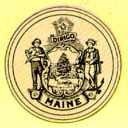The Making of the 50 States: Maine
Part 2: The Rest of the Story After this war, the Massachusetts colony offered 100-acre lots in Maine free. Many people took advantage of this offer, and the population doubled from 12,000 to 24,000 between 1743 and 1763. The
people who lived in Maine weren't too happy about British
taxes, and they staged their own version of the
Boston
Tea Party, burning
a tea storage building at York. Maine was again a
battleground during the Revolutionary War, especially along
the coastline. In fact, the first naval battle of This drive for independence didn't end with the American victory. In 1785, the first newspaper in Maine, the Falmouth Gazette, began campaigning for independence from Massachusetts. That colony, however, wasn't about to let Maine become its own state and resisted for many years, finally agreeing to an independent Maine in 1819.
First page > In the Beginning > Page 1, 2
|
|
Social Studies for Kids
copyright 2002–2024
David White



 the
war took place in Maine, when Americans there seized the
British ship Margaretta off the coast of Machias. The
British, of course, pounded the American settlements, and
the war was on.
the
war took place in Maine, when Americans there seized the
British ship Margaretta off the coast of Machias. The
British, of course, pounded the American settlements, and
the war was on.  A
year later, Maine became the 23rd state on March 15, 1820, as part of the
A
year later, Maine became the 23rd state on March 15, 1820, as part of the

